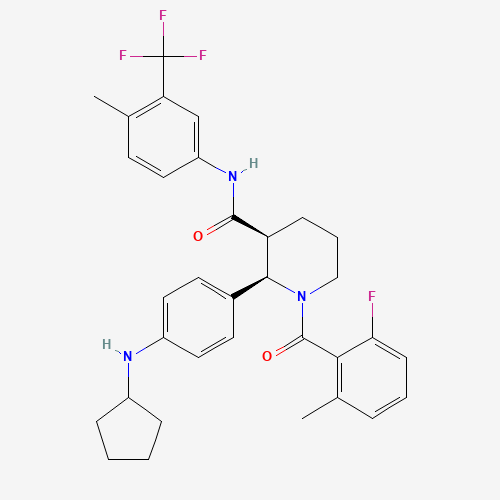| Pharmaceutical Information |
| Drug Name |
Avacopan |
| Drug ID |
BADD_D02530 |
| Description |
Anti-neutrophil cytoplasmic (auto)antibody (ANCA)-associated vasculitis (AAV) is a rare (estimated incidence of 3 cases per 100,000 per year) form of "pauci-immune" systemic small-vessel vasculitis typified by the presence of ANCAs in the serum.[A240249, A240254, A227003] The full spectrum of AAV includes granulomatosis with polyangiitis (GPA), microscopic polyangiitis (MPA), eosinophilic granulomatosis with polyangiitis (EGPA), and drug-induced AAV. AAV may be associated with necrotizing and crescentic glomerulonephritis (NCGN).[A240249, A240254] Despite complex pathophysiology, studies over the past ~2 decades have identified a key role for the alternative complement pathway and, in particular, the interaction between the anaphylatoxin fragment C5a and its cognate C5aR receptor in AAV.[A240254, A240259, A240264, A240269] Avacopan (formerly CCX168) is an allosteric C5aR antagonist indicated for use in AAV.[A240269, A240329, L38919]
Avacopan was granted FDA approval on October 8, 2021, and is currently marketed under the name TAVNEOS by ChemoCentryx, Inc.[L38919] |
| Indications and Usage |
Avacopan is indicated for the adjunctive treatment of adult patients with severe active anti-neutrophil cytoplasmic autoantibody (ANCA)-associated vasculitis (granulomatosis with polyangiitis and microscopic polyangiitis; GPA/MPA) in combination with standard therapy including glucocorticoids. Avacopan does not eliminate the need for glucocorticoids.[L38919] |
| Marketing Status |
approved; investigational |
| ATC Code |
L04AA59 |
| DrugBank ID |
DB15011
|
| KEGG ID |
D11093
|
| MeSH ID |
C000620232
|
| PubChem ID |
49841217
|
| TTD Drug ID |
D0MR4Q
|
| NDC Product Code |
73556-168; 49187-0834; 67651-0363; 67651-0364 |
| UNII |
O880NM097T
|
| Synonyms |
avacopan | CCX168 |
|
| Chemical Information |
| Molecular Formula |
C33H35F4N3O2 |
| CAS Registry Number |
1346623-17-3 |
| SMILES |
CC1=C(C(=CC=C1)F)C(=O)N2CCCC(C2C3=CC=C(C=C3)NC4CCCC4)C(=O)NC5=CC(=C(C=C5)C)C(F)(
F)F |
| Chemical Structure |

|
|
| ADRs Induced by Drug |
|
|
*The priority for ADR severity classification is based on FAERS assessment, followed by the most severe level in CTCAE rating. If neither is available, it will be displayed as 'Not available'.
**The 'Not Available' level is hidden by default and can be restored by clicking on the legend twice..
|
|
|

